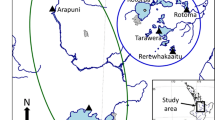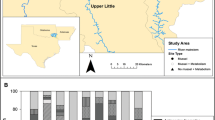Abstract
Animal excretion provides nutrients for primary productivity and can be a crucial component of ecosystem nutrient cycling. The concentrations of carbon (C), nitrogen (N), and phosphorus (P) in an animal’s excretion are strongly influenced by the C:N:P stoichiometry (molar ratios) of its body and of the food it eats. We measured the C:N:P ratios of quagga mussel (Dreissena rostriformis bugensis) tissues and excreta and of seston across wide environmental and spatial gradients in the upper Laurentian Great Lakes. We then investigated how mussel excretion rates were impacted by stoichiometric mismatch—the difference between the C:P ratios of mussel tissues and the C:P ratios their food. Quagga mussel internal C:N:P stoichiometry varied significantly across sites and seasons, driven primarily by changes in tissue P concentrations. When mussel tissues had substantially lower C:P ratios than seston (that is, strong stoichiometric mismatch), mussels excreted significantly less N and P relative to C. Excretion C:N ratios varied by nearly threefold, while C:P ratios varied by tenfold. The effect of the stoichiometric mismatch on excretion stoichiometry was more dramatic in the spring, when mussels had higher tissue P concentrations, than in the summer. This suggests seasonality in mussel P demand. Our results challenge the assumption of strict internal homeostasis in consumers and demonstrate that food and tissue stoichiometry need to be considered to predict consumer excretion stoichiometry. These findings help to better understand the impact of consumer-driven nutrient cycling in aquatic environments and quagga mussel contributions to the nutrient budgets of invaded ecosystems.






Similar content being viewed by others
Data Availability
Data is available at the Data Repository for the University of Minnesota (DRUM) at https://doi.org/10.13020/A6M5-HD07.
References
Anderson TR, Hessen DO, Elser JJ, Urabe J. 2005. Metabolic stoichiometry and the fate of excess carbon and nutrients in consumers. Am Nat 165(1):1–15. https://doi.org/10.1086/426598.
Arnott DL, Vanni MJ. 1996. Nitrogen and phosphorus recycling by the zebra mussel (Dreissena polymorpha) in the western basin of Lake Erie. Can J Fish Aquat Sci 53:646–659.
Atkinson CL, Vaughn CC, Forshay KJ, Cooper JT. 2013. Aggregated filter-feeding consumers alter nutrient limitation-consequences for ecosystem and community dynamics. Ecology 94:1359–1369.
Atkinson CL, Capps KA, Rugenski AT, Vanni MJ. 2017. Consumer-driven nutrient dynamics in freshwater ecosystems: from individuals to ecosystems. Biol Rev 92(4):2003–2023. https://doi.org/10.1111/brv.12318.
Balseiro E, Albariño R. 2006. C-N mismatch in the leaf litter–shredder relationship of an Andean Patagonian stream detritivore. J N Am Benthol Soc 25(3):607–615. https://doi.org/10.1899/0887-3593200625[607:CMITLL]2.0.CO;2.
Bayne BL, Widdows J. 1978. The physiological ecology of two populations of Mytilus edulis L. Oecologia 37(2):137–162. https://doi.org/10.1007/BF00344987.
Bracken MES. 2017. Stoichiometric mismatch between consumers and resources mediates the growth of rocky intertidal suspension feeders. Front Microbiol. https://doi.org/10.3389/fmicb.2017.01297.
Bullejos FJ, Carrillo P, Gorokhova E, Medina-Sánchez JM, Villar-Argaiz M. 2014. Nucleic acid content in crustacean zooplankton: bridging metabolic and stoichiometric predictions. PLoS ONE. https://doi.org/10.1371/journal.pone.0086493.
Darriba S, San Juan F, Guerra A. 2005. Energy storage and utilization in relation to the reproductive cycle in the razor clam Ensis arcuatus (Jeffreys, 1865). ICES J Mar Sci 62(5):886–896. https://doi.org/10.1016/j.icesjms.2005.02.010.
Diehl S, Berger SA, Uszko W, Stibor H. 2022. Stoichiometric mismatch causes a warming-induced regime shift in experimental plankton communities. Ecology 103(5):e3674. https://doi.org/10.1002/ecy.3674.
Downs KN, Hayes NM, Rock AM, Vanni MJ, González MJ. 2016. Light and nutrient supply mediate intraspecific variation in the nutrient stoichiometry of juvenile fish. Ecosphere 7(10):e01452. https://doi.org/10.1002/ecs2.1452.
Elser JJ, Urabe J. 1999. The stoichiometry of consumer-driven nutrient recycling: theory, observations, and consequences. Ecol Soc Am 80(3):735–751.
Elser JJ, Sterner R, Gorokhova E, Fagan W, Markow T, Cotner J, Harrison J, Hobbie S, Odell G, Weider L. 2000. Biological stoichiometry from genes to ecosystems. Ecol Lett 3(6):540–550. https://doi.org/10.1111/j.1461-0248.2000.00185.x.
Glyshaw PW, Riseng CM, Nalepa TF, Pothoven SA. 2015. Temporal trends in condition and reproduction of quagga mussels (Dreissena rostriformis bugensis) in southern Lake Michigan. J Great Lakes Res 41:16–26. https://doi.org/10.1016/j.jglr.2015.08.006.
Haltiner L, Zhang H, Anneville O, Ventura L, Deweber J, Hesselschwerdt J, Koss M, Rasconi S, Rothhaupt K-O, Schick R, Schmidt B, Spaak P, Teiber-Sießegger P, Wessels M, Zeh M, Dennis S. 2022. The distribution and spread of quagga mussels in perialpine lakes north of the Alps. Aquat Invasions 17:153.
He X, Wang W-X. 2006. Relative importance of inefficient feeding and consumer excretion to organic carbon flux from Daphnia. Freshw Biol 51(10):1911–1923. https://doi.org/10.1111/j.1365-2427.2006.01631.x.
Hessen DO, Anderson TR. 2008. Excess carbon in aquatic organisms and ecosystems: physiological, ecological, and evolutionary implications. Limnol Oceanogr 53(4):1685–1696. https://doi.org/10.4319/lo.2008.53.4.1685.
Li J, Ianaiev V, Huff A, Zalusky J, Ozersky T, Katsev S. 2021. Benthic invaders control the phosphorus cycle in the world’s largest freshwater ecosystem. PNAS 118(6):e2008223118.
Lindim C. 2015. Modeling the impact of Zebra mussels (Dreissena polymorpha) on phytoplankton and nutrients in a lowland river. Ecol Model 301:17–26. https://doi.org/10.1016/j.ecolmodel.2015.01.012.
MacLellan-Hurd R-A. 2020. Quagga mussel induced phosphorus cycling changes in Lake Michigan [The University of Wisconsin - Milwaukee]. https://www.proquest.com/docview/2457720465/abstract/B802B09BAD0A4CB7PQ/1
Mäkelin S, Villnäs A. 2022. Food sources drive temporal variation in elemental stoichiometry of benthic consumers. Limnol Oceanogr 67(4):784–799. https://doi.org/10.1002/lno.12034.
Minor EC, Brinkley G. 2022. Alkalinity, pH, and pCO2 in the Laurentian Great Lakes: an initial view of seasonal and inter-annual trends. J Great Lakes Res 48(2):502–511. https://doi.org/10.1016/j.jglr.2022.01.005.
Morehouse RL, Dzialowski AR, Jeyasingh PD. 2013. Impacts of excessive dietary phosphorus on zebra mussels. Hydrobiologia 707(1):73–80. https://doi.org/10.1007/s10750-012-1407-3.
Mosley C, Bootsma H. 2015. Phosphorus recycling by profunda quagga mussels (Dreissena rostriformis bugensis) in Lake Michigan. J Great Lakes Res 41:38–48. https://doi.org/10.1016/j.jglr.2015.07.007.
Murphy J, Riley JP. 1962. A modified single solution method for the determination of phosphate in natural waters. Anal Chim Acta 27:31–36. https://doi.org/10.1016/S0003-2670(00)88444-5.
Naddafi R, Eklöv P, Pettersson K. 2009. Stoichiometric constraints do not limit successful invaders: zebra mussels in Swedish Lakes. PLoS ONE. https://doi.org/10.1371/journal.pone.0005345.
Naddafi R, Goedkoop W, Grandin U, Eklöv P. 2012. Variation in tissue stoichiometry and condition index of zebra mussels in invaded Swedish lakes. Biol Invasions 14(10):2117–2131. https://doi.org/10.1007/s10530-012-0218-9.
Nalepa TF, Gardner WS, Malczyk JM. 1991. Phosphorus cycling by mussels (Unionidae: Bivalvia) in Lake St. Clair. Hydrobiologia 219(1):239–250. https://doi.org/10.1007/BF00024758.
Nalepa TF, Fanslow DL, Pothoven SA. 2010. Recent changes in density, biomass, recruitment, size structure, and nutritional state of Dreissena populations in southern Lake Michigan. J Great Lakes Res 36:5–19. https://doi.org/10.1016/j.jglr.2010.03.013.
Ozersky T, Evans DO, Ginn BK. 2015. Invasive mussels modify the cycling, storage and distribution of nutrients and carbon in a large lake. Freshw Biol 60(4):827–843. https://doi.org/10.1111/fwb.12537.
Pothoven SA, Elgin AK. 2019. Dreissenid veliger dynamics along a nearshore to offshore transect in Lake Michigan. J Great Lakes Res 45(2):300–306. https://doi.org/10.1016/j.jglr.2019.01.001.
Prater C, Wagner N, Frost P. 2018. Seasonal effects of food quality and temperature on body stoichiometry, biochemistry, and biomass production in Daphnia populations. Limnol Oceanogr 63(4):1727–1740. https://doi.org/10.1002/lno.10803.
Sitters J, Bakker ES, Veldhuis MP, Veen GF, Olde Venterink H, Vanni MJ. 2017. The stoichiometry of nutrient release by terrestrial herbivores and its ecosystem consequences. Front Earth Sci. https://doi.org/10.3389/feart.2017.00032.
Smaal AC, Vonck AMPA. 1997. Seasonal variation in C, N and P budgets and tissue composition of the mussel Mytilus edulis. Mar Ecol Progr Ser 153:167–179. https://doi.org/10.3354/meps153167.
Steinberg DK, Landry MR. 2017. Zooplankton and the ocean carbon cycle. Annu Rev Mar Sci 9(1):13–444. https://doi.org/10.1146/annurev-marine-010814-015924.
Sterner RW. 1990. The ratio of nitrogen to phosphorus resupplied by herbivores: zooplankton and the algal competitive arena. Am Nat 136(2):209–229. https://doi.org/10.1086/285092.
Sterner R. 1997. Modelling interactions of food quality and quantity in homeostatic consumers. Freshw Biol 38(3):473–481. https://doi.org/10.1046/j.1365-2427.1997.00234.x.
Sterner RW, Elser JJ. 2002. Ecological stoichiometry: the biology of elements from molecules to the biosphere. Princeton University Press.
Stewart SD, Hamilton DP, Baisden WT, Verburg P, Duggan IC. 2018. The role of mobile consumers in lake nutrient cycles: a brief review. Hydrobiologia 818(1):11–29. https://doi.org/10.1007/s10750-018-3603-2.
Tiegs SD, Berven KA, Carmack DJ, Capps KA. 2016. Stoichiometric implications of a biphasic life cycle. Oecologia 180(3):853–863. https://doi.org/10.1007/s00442-015-3504-2.
Torres LE, Vanni MJ. 2007. Stoichiometry of nutrient excretion by fish: interspecific variation in a hypereutrophic lake. Oikos 116(2):259–270. https://doi.org/10.1111/j.0030-1299.2007.15268.x.
Tyner E, Bootsma H, Lafrancois BM. 2015. Dreissenid metabolism and ecosystem-scale effects as revealed by oxygen consumption. J Great Lakes Res 41:27–37. https://doi.org/10.1016/j.jglr.2015.05.009.
Urabe J. 1993. N and P cycling coupled by grazers’ activities: food quality and nutrient release by Zooplankton. Ecology 74(8):2337–2350. https://doi.org/10.2307/1939586.
Vanderploeg HA, Johengen TH, Liebig JR. 2009. Feedback between zebra mussel selective feeding and algal composition affects mussel condition: did the regime changer pay a price for its success? Freshw Biol 54(1):47–63. https://doi.org/10.1111/j.1365-2427.2008.02091.x.
Vanderploeg HA, Sarnelle O, Liebig JR, Morehead NR, Robinson SD, Johengen TH, Horst GP. 2017. Seston quality drives feeding, stoichiometry and excretion of zebra mussels. Freshw Biol 62(4):664–680. https://doi.org/10.1111/fwb.12892.
Vanni MJ, Flecker AS, Hood JM, Headworth JL. 2002. Stoichiometry of nutrient recycling by vertebrates in a tropical stream: linking species identity and ecosystem processes. Ecol Lett 5(2):285–293. https://doi.org/10.1046/j.1461-0248.2002.00314.x.
Welschmeyer NA. 1994. Fluorometric analysis of chlorophyll a in the presence of chlorophyll b and pheopigments. Limnol Oceanogr 39(8):1985–1992. https://doi.org/10.4319/lo.1994.39.8.1985.
Williamson F, Ozersky T. 2019. Lake characteristics, population properties and invasion history determine impact of invasive bivalves on lake nutrient dynamics. Ecosystems 22(8):1721–1735. https://doi.org/10.1007/s10021-019-00371-z.
Zalusky J. 2021. Starvation in the depths: how quagga mussels persist in the most challenging habitat of the Laurentian great lakes [University of Minnesota]. http://conservancy.umn.edu/handle/11299/224891
Zhang C, Jansen M, De Meester L, Stoks R. 2016. Energy storage and fecundity explain deviations from ecological stoichiometry predictions under global warming and size-selective predation. J Anim Ecol 85(6):1431–1441. https://doi.org/10.1111/1365-2656.12531.
Acknowledgements
We thank the crew of the R/V Blue Heron, Dr. Jiying Lee, and Vadym Ianaiev for their assistance with field work as well as Matt Rigdon and Drake Best for their help processing field samples. We also thank Julia Agnich and Sandy Brovold for their assistance processing laboratory samples and Nathan Kossnar for GIS assistance. This work was supported by the University of Minnesota’s Water Resources Science graduate program and the National Science Foundation under Grant No. OCE-1737368.
Funding
This study was supported by funding from the University of Minnesota’s Water Resources Science graduate program and the National Science Foundation under Grant No. OCE-1737368.
Author information
Authors and Affiliations
Contributions
TO, SK, and AH conceived of the study. AH, JZ, SK, and TO conducted field work. AH and JZ conducted lab work and analyzed samples and data. AH wrote the original manuscript, and all authors contributed to and provided feedback on various drafts of the paper.
Corresponding author
Supplementary Information
Below is the link to the electronic supplementary material.
Rights and permissions
Springer Nature or its licensor (e.g. a society or other partner) holds exclusive rights to this article under a publishing agreement with the author(s) or other rightsholder(s); author self-archiving of the accepted manuscript version of this article is solely governed by the terms of such publishing agreement and applicable law.
About this article
Cite this article
Huff, A., Zalusky, J., Katsev, S. et al. Variable Tissue Stoichiometry Influences Nutrient Recycling by Invasive Freshwater Mussels in Nutrient-Poor Lakes. Ecosystems 26, 1543–1555 (2023). https://doi.org/10.1007/s10021-023-00849-x
Received:
Accepted:
Published:
Issue Date:
DOI: https://doi.org/10.1007/s10021-023-00849-x




